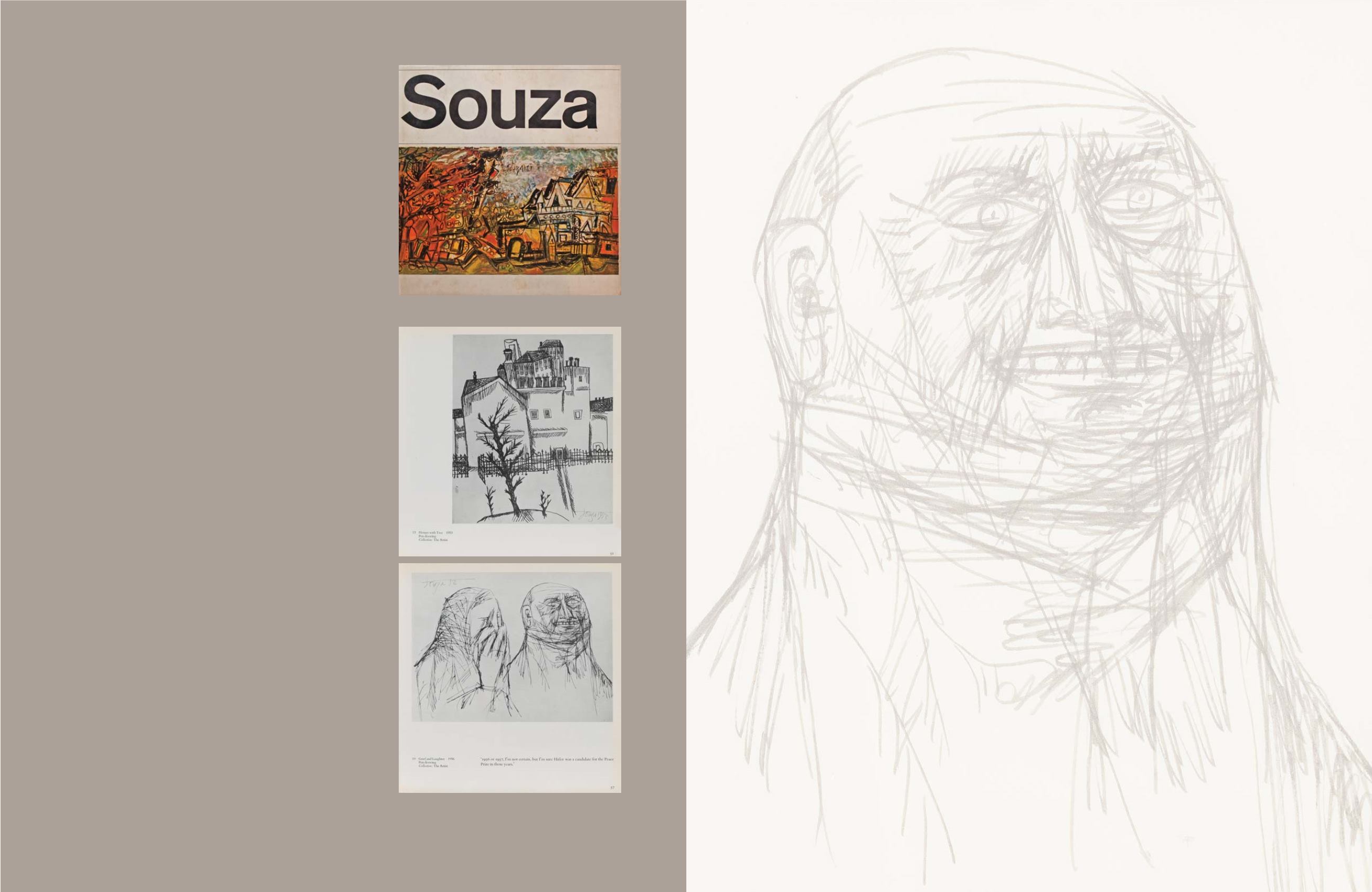

68
69
According toMullins, “Figurative art presents noproblems
for Souza because he has succeeded in creating images
that are entirely personal, yet recognisable at the same
time.” (Mullins, p. 36) Lot 47, made in 1956, is a poignant
example of Souza’s heads. A year before, he created a
suite of six ink drawings titled
Six Gentlemen of our Times
,
depicting men who appeared like “a combined portrait
of Dr Jekyll and Mr Hyde, sly, evil and at the same time
terrified.” (Geeta Kapur,
Contemporary Indian Artists
,
New Delhi: Vikas Publications, 1978, p. 27)
These anatomically distorted faces—with the eyes placed
too high on the forehead, teeth bared and gnashing, and
marked by a fury of criss‒crossing lines—are emphasised
in the present lot as well. At first glance, the drawing,
which is titled
Grief and Laughter
, appears to show two
faces expressing the universal emotions of “grief”, as
seen in the remorseful expression of the figure on the
left, and “laughter” in the smiling face of the figure on
the right. But further scrutiny reveals that the drawing is
not so straightforward. The “laughter” of the right figure
seems transfixed in horror, and the wide‒eyed, smiling
expression borders on surreal. However, as Mullins puts
it: “Souza’s imagery is not a surrealist vision – a self‒
conscious aesthetic shock – so much as a spontaneous
re‒creation of the world as he has seen it, distilled in the
mind by a host of private experiences and associations...
They are full of apparent contradictions: agony and wit,
pathos and satire, aggression and pity. Their impact is
certain, but few people are able to explain what has hit
them.” (Mullins, p. 39)
T
he following lots (48 and 49) were once part
of the personal collection of British writer and
art critic Edwin Mullins, and were featured
in his seminal 1962 monograph
Souza
—a book still
considered critical to the study of the artist’s oeuvre.
A leading authority on art, Oxford‒educated Mullins
spent his career as the art critic for
SundayTelegraph
and
Daily Telegraph
and as a cultural television presenter
for the BBC from the 1960s through the 1980s. In
that time, he covered important developments in art,
within UK and globally, wrote famously about artists
such as Van Gogh, Georges Braque and Alfred Wallis,
and historical accounts of various cultural events.
Mullins' work led him to interact with many artists
of that time, from Salvador Dali, Barbara Hepworth
and Henry Moore, to India’s Souza, who was living in
London at the time.
As Mullins notes, between 1949 and 1955 Souza had a
difficult time making his career as an artist in London,
often shuffling between galleries carrying enormous
paintings only to have them rejected. At the same
time, he studied drawing at the Central School of Art,
giving him reason to continue residing in England.
Living in a single roomwith his wife and baby daughter,
“There was not much space for non‒essentials, and
he [Souza] recalls how a next‒door neighbour once
complained that he had been throwing drawings in
the communal dustbin. Apparently her children had
been rummaging, and had found them. They were
drawings which, she said ‘were not quite nice’, and
she accused him of being a corrupting influence on
the young. Souza was rather flattered. It was the first
time anyone in England had taken notice of his work.”
(Edwin Mullins,
Souza
, London: Anthony Blond Ltd.,
1962, pp. 21, 23)
Lot 48, dated 1953, was sketched during Souza’s early
years in London and appears to be a quaint scene of
the cityscape composed in simple rectilinear lines.
Souza employs his signature cross‒hatching technique
in this drawing, including the parallel lines which give
the appearance of harpooning spears. These serve to
create an ominous mood, which intensified in Souza’s
later work.
Lots 49 and 50 were once part of Edwin Mullins’ private collection
and were published (pp. 51, 57) in his seminal 1962 monograph
on the artist.
Cover of Edwin Mullins,
Souza
, London: Anthony Blond Ltd., 1962


















